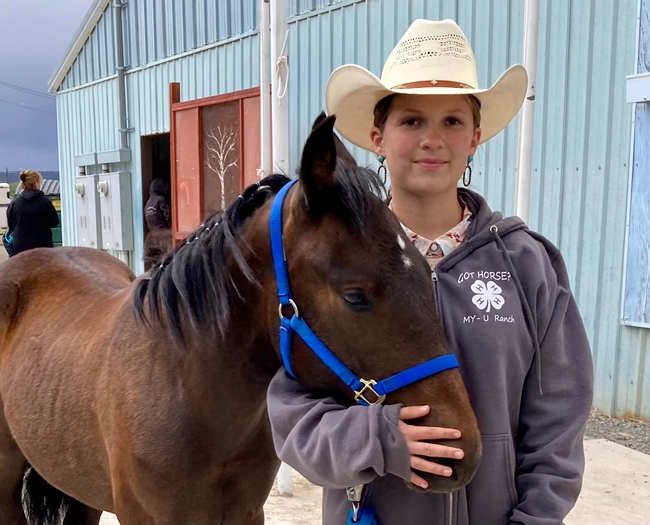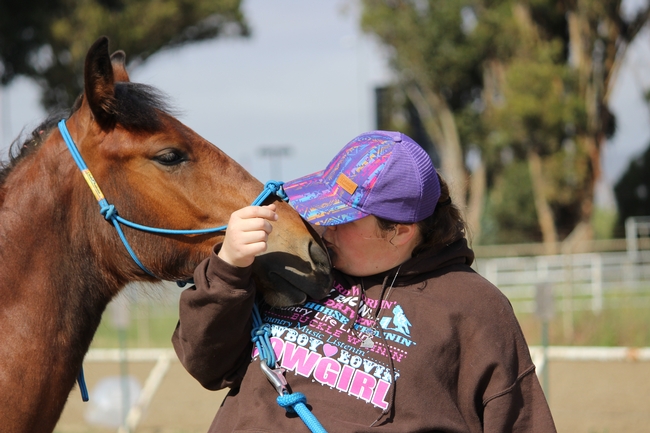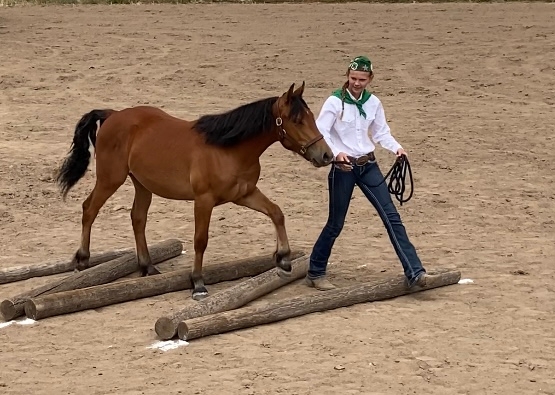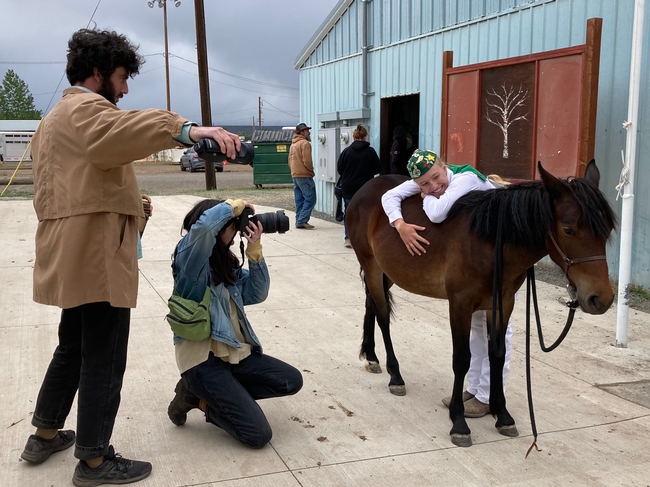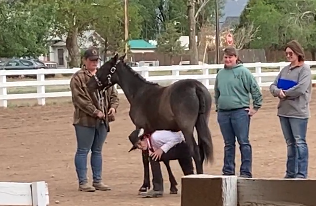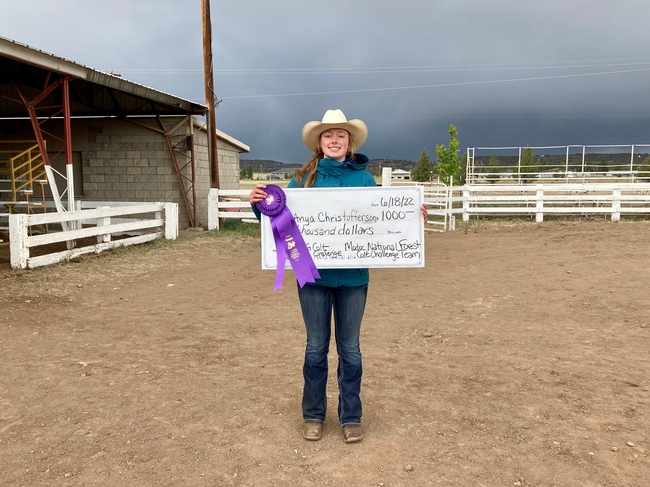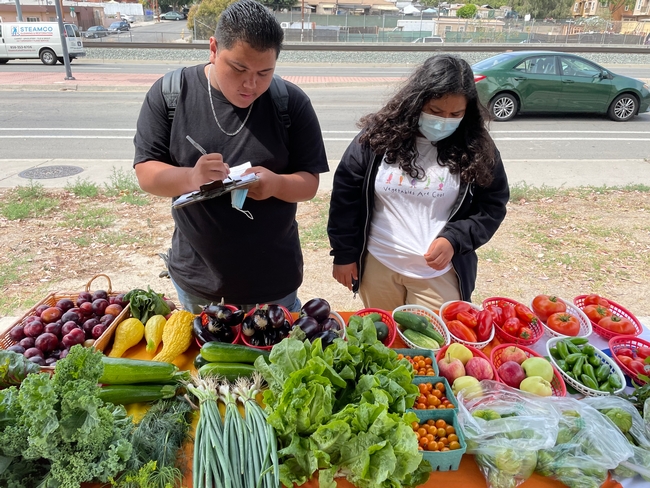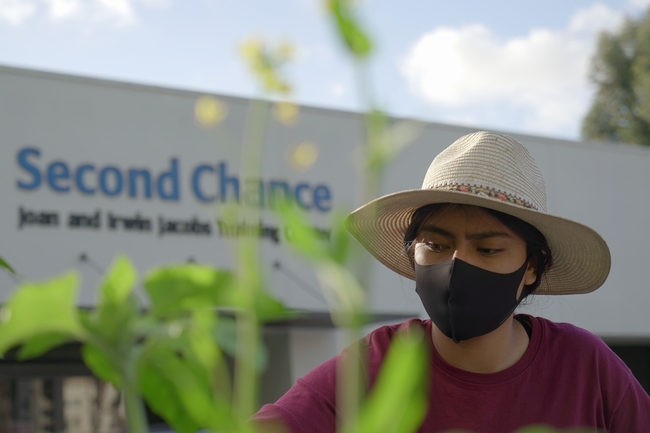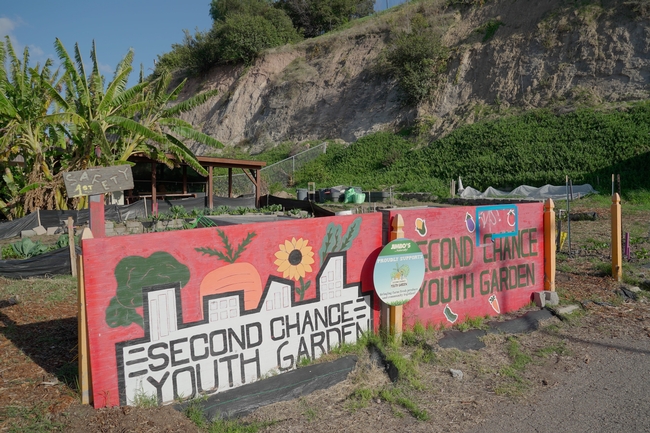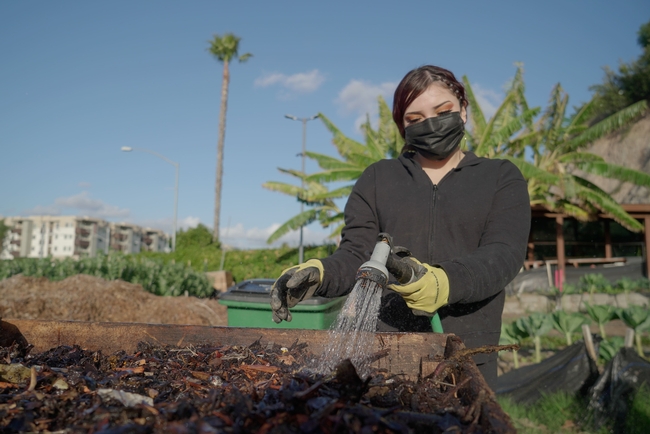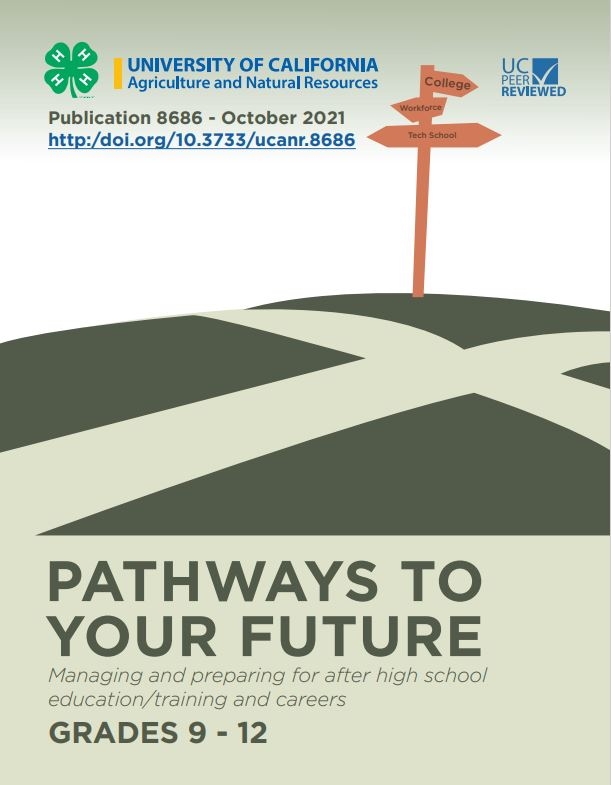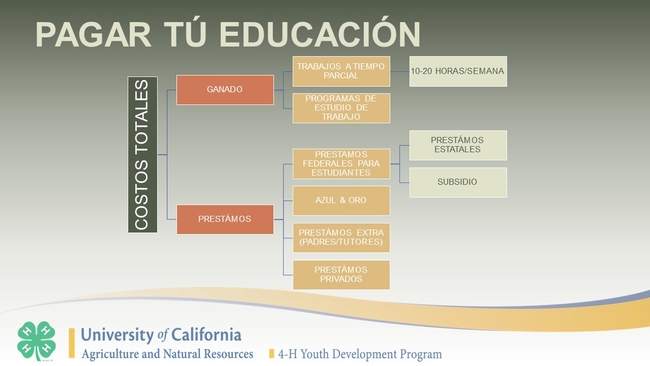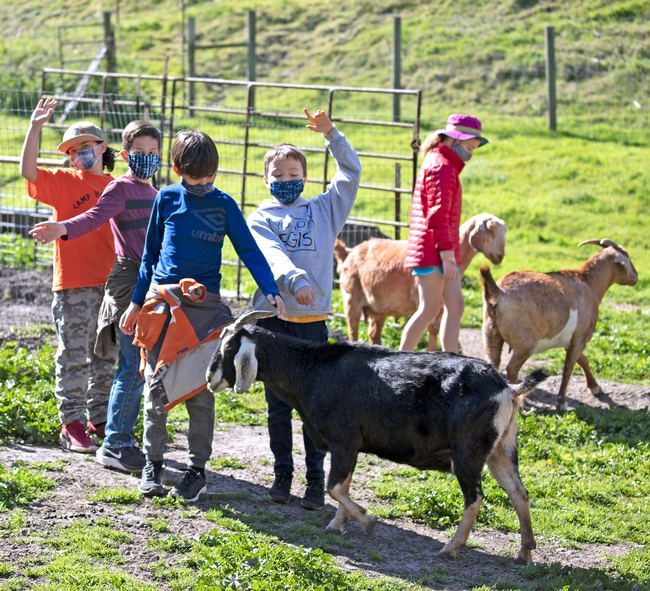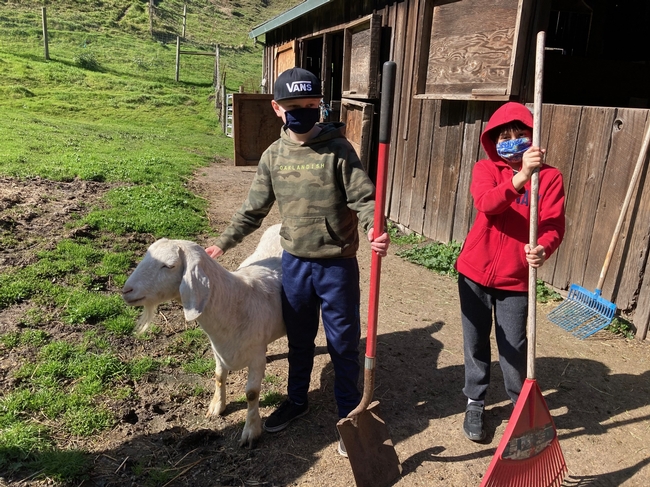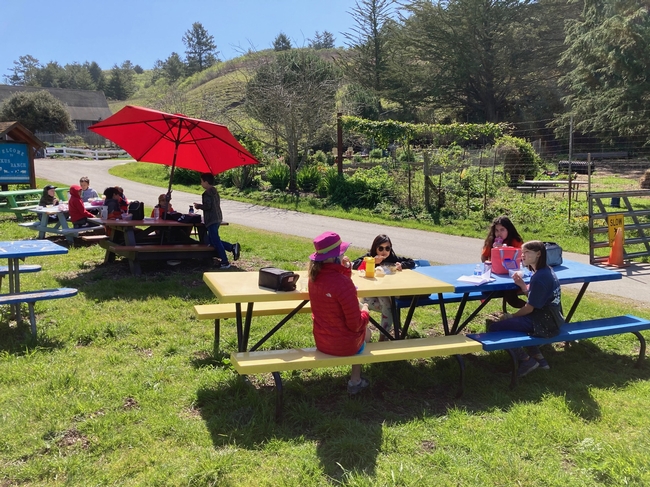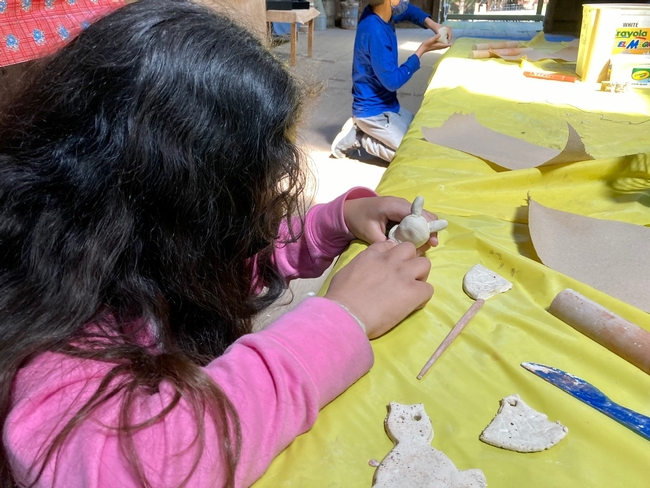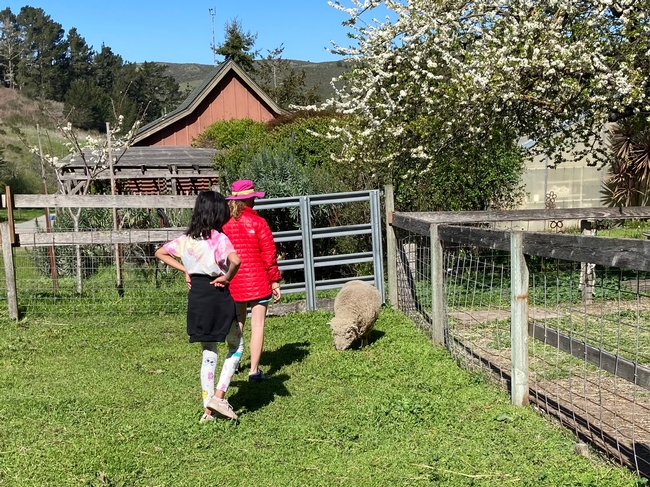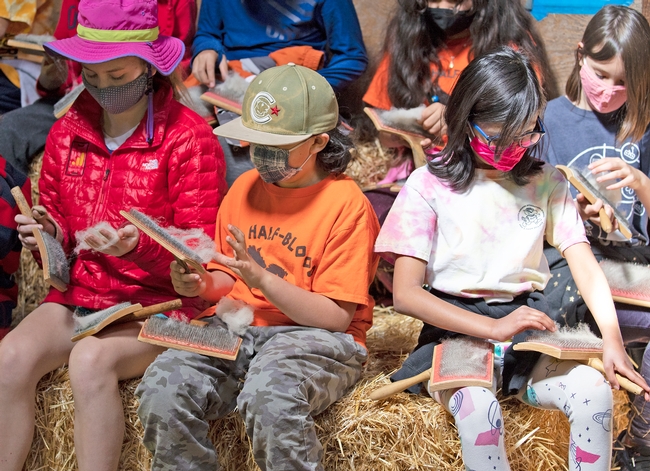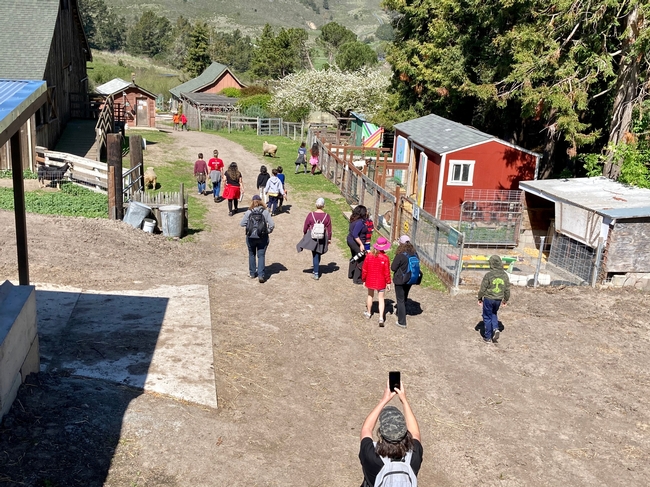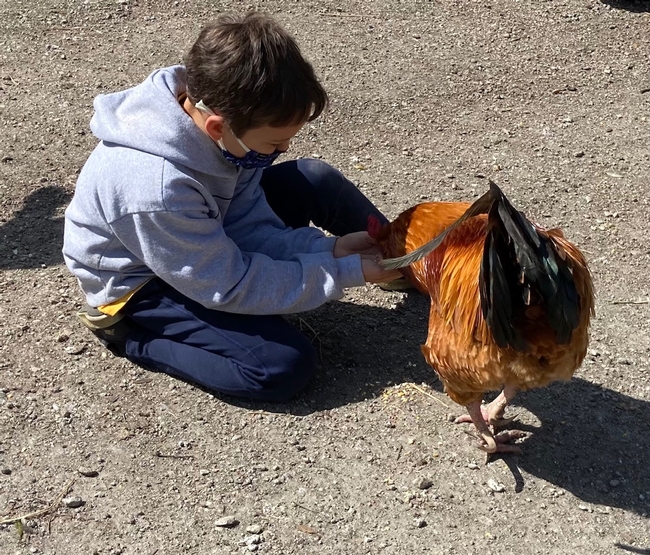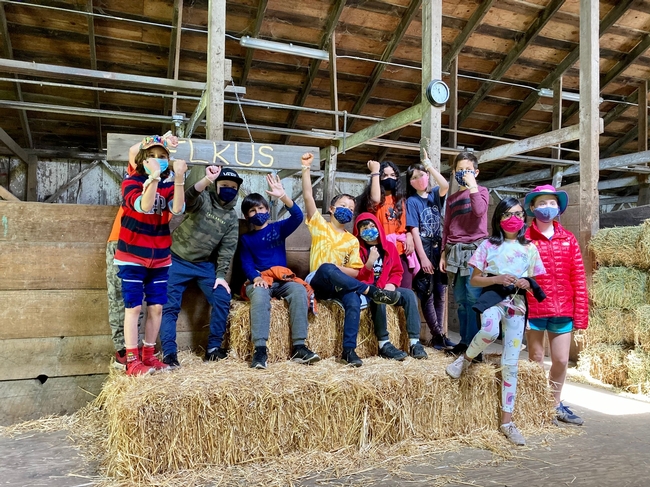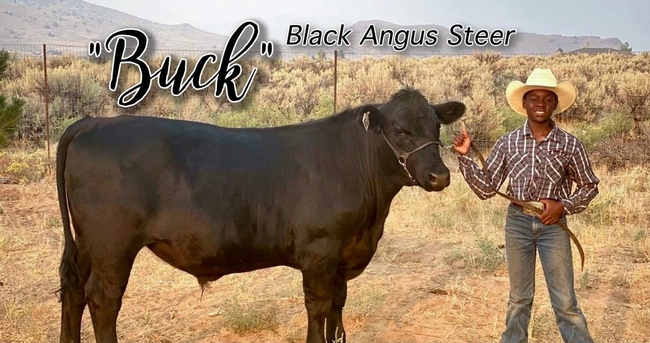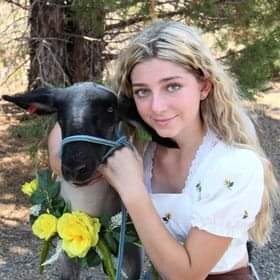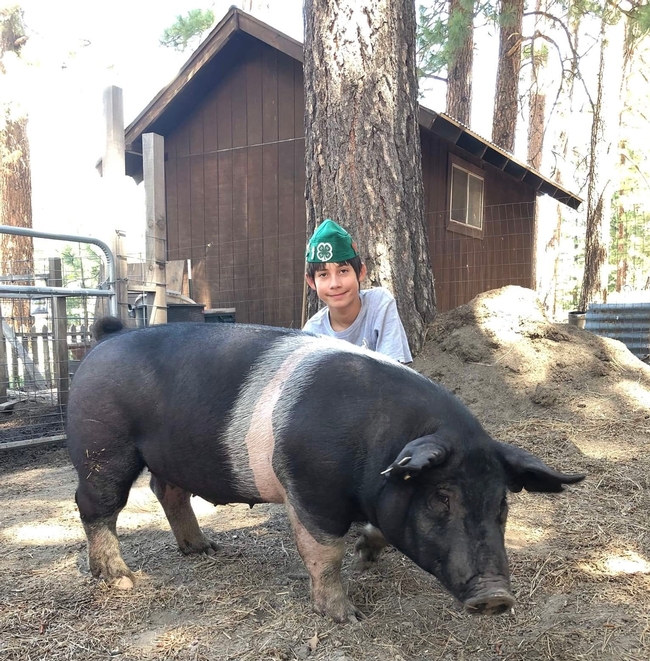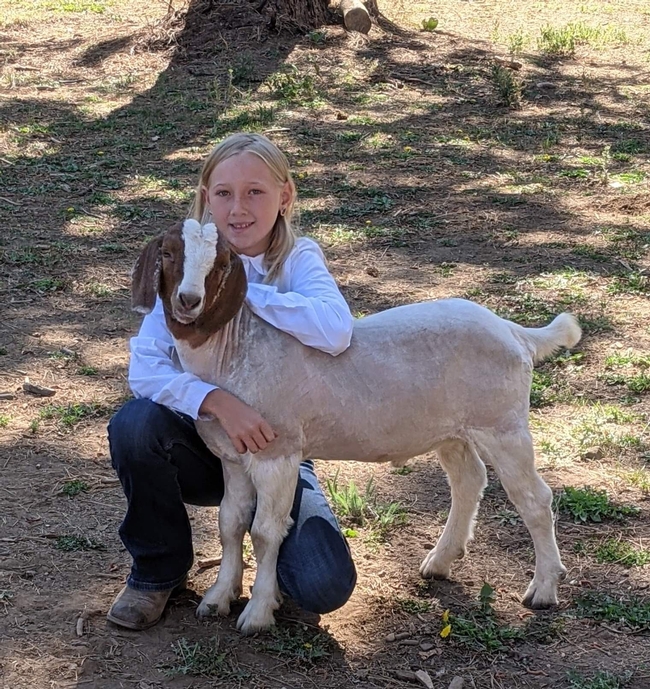Posts Tagged: Youth Development
Wild horses and youth learn patience and trust from each other
“There is much we can learn from a friend who happens to be a horse.” — Aleksandra Layland
“Training mustangs is just so much fun,” said Aubrielle, as a chestnut-colored filly named Zuri nuzzled the 4-H member from Shasta County. Six months earlier, the young wild horse was wary of being touched. Now she was sporting accessories in her styled mane that matched the teenager's turquoise jewelry.
Over the past few years, UC Cooperative Extension in Modoc County has partnered with Modoc National Forest to provide public outreach and education to support the placement and care of wild horses from Devil's Garden at the northeastern corner of California. Adopting foals reduces overpopulation of wild horses, which can harm rangeland and the health of the mustangs themselves.
This year Laura Snell, UC Cooperative Extension livestock and natural resources advisor in Modoc County, assigned weanling wild horses to 40 youth between the ages of 9 and 19 from all over the state. The mustangs were 4 to 6 months old in January when they were picked up in Alturas and taken home by California 4-H and FFA members, who feed and care for them.
“The moment when I got to touch him for the first time is probably one of the biggest parts of training as well as my progress with him,” said Morgan of Monterey County, who spent hours in the stall with Bowie trying to gain his trust.
“It was really amazing to me that I was able to touch him on day 5,” she said. “In the videos I watched leading up to getting him, most of the time it took one week to three weeks for the people in the videos to touch their wild mustangs. At that moment is when you really start to make that bond with a wild mustang.”
“The moment when I got to remove his tag was a huge part as well because at that moment you know that the mustang trusts you enough that he is letting you get that close to remove the tag,” Morgan said.
The young trainers teach the horses to wear a halter, to load and unload from a horse trailer and to navigate through obstacles. Some participants also work on tricks such as laying their horse down, walking the horse backward and walking under the horse. In June, the participants gathered in Alturas to show their progress.
“It provides them an opportunity to seek out adult mentors who are horse trainers, learn responsibility, and learn a variety of things about caring for a wild horse and learning more about themselves in the process,” said Snell.
“We find that the youth do very well with wild horses. It's really a two-way street, with the horses learning just as much as the youth are in the six months they are in training,” she added.
Sisters Kailey and Maddi in San Benito County both adopted weanling horses. Removing the tag after about three weeks was a turning point for Maddi and her horse Fiona.
“The significance of getting the tag off was we hadn't been able to get near her at all,” said Maddi. “She had some aggression toward people out of fear. So getting past that, getting to the point where she trusted me and I could get that halter on her and get close enough to get that tag off was just a huge achievement. After that, once she trusted me, she started doing really, really well and flying through her training.”
Because wildfires are part of life in California, she taught Fiona to step over flames so she won't be afraid if they need to evacuate, Maddi told KSBW reporter Brisa Colon.
“It has been amazing to be able to share this experience with another very close family,” said Aubrielle's mother Ashley Phipps. “Our daughters have gone through the entire journey together starting with visiting the corrals to pick horses together, all the way through the training process. My daughter is older than Brooklin and has been a great mentor to her, teaching Brooklin and her horse along the way. It has been such a confidence builder for my daughter! Our girls will never forget this experience!!! And I loved every moment of watching them grow through the ups and downs. This program is such a blessing.”
To qualify for the program, applicants must fill out an application which includes being enrolled in a horse program such as the 4-H Equine Project, show they have facilities and feed for the animals, designate a mentor and have their parents' approval.
The trainers and their horses competed in the Devil's Garden Colt Challenge on June 18 in Alturas, vying for awards in halter, showmanship and obstacle course with youth from 13 counties participating. Prizes totaled over $3,000.
Youth-run garden provides 10,000 pounds of produce for San Diego families
UC SAREP's Sustainable Agriculture and Food Systems grant helps support Second Chance garden
Fifteen-year-old Xavier knows the anger within him will never leave. “I can't ever get rid of it,” he said.
“I've always wanted to just fight for no reason; I just had an anger issue, losing my temper quick with people,” added Xavier, a ninth-grader in San Diego County. “I have high expectations of myself.”
Xavier is working to keep his emotions under control, and he has found a sense of calm through his volunteer work. He was an intern – and then a peer supervisor – in the youth-run garden of Second Chance, a San Diego-based organization that works to break the cycles of poverty and incarceration by providing housing and job training to adults and young people.
Operating their garden as a small farm business, youth in the program, ages 14 to 21, offer produce to the community through their farm stand and a CSA (Community Supported Agriculture) model.
“The project incorporates a ‘farm to fork' approach in which youth not only experience how to grow food, but how to cook and eat healthfully,” said Gail Feenstra, director of the University of California Sustainable Agriculture Research and Education Program, which has a grant program that funds research and education projects – such as the youth garden – supporting sustainable food systems.
“Second Chance works primarily with youth in communities of color, providing them with training and also helping them develop confidence in themselves,” Feenstra said.
Filling a critical need for fresh produce
Caelli Wright, program manager of the Second Chance youth garden, said that grant funds from SAREP – a program of UC Agriculture and Natural Resources – have been used to purchase the supplies needed to sustain the program. The garden has filled a critical need for produce during the COVID-19 pandemic.
“After the pandemic hit, we recognized the increased need for fresh food in our neighborhoods,” Wright said. “That need was already there – southeast San Diego is considered a ‘food swamp' or ‘food apartheid', if you will – and with the onset of COVID, that need just escalated with unemployment and complications in our food production systems.”
Through a partnership with UC San Diego Center for Community Health and Encanto Elementary School (located down the block from the garden), donations enabled the program to give its CSA shares to about 25 families at Encanto. Over the course of the pandemic, the youth have grown 10,000 pounds of produce to donate.
At the same time, the program helps the young participants grow. For Xavier, being outdoors with peers empowered him to develop positive relationships. Previously, as a student in a charter school program, he was not accustomed to interacting with people and groups. Volunteering in the youth garden has given him a fresh perspective and understanding of others.
“Learning to be patient with people and [to] accept sometimes that if I don't know something, I need to ask about it, because I used to be so in my ego that I thought I knew everything,” Xavier explained. “But I don't know everything – I just learned to accept some things…that's just being part of life. And that's something that the garden has helped me with, personally.”
Opportunities for personal, social growth
Developing – and redeveloping – social skills are especially important for students, as they return from the disconnections associated with remote learning.
“Right now, with a lot of students facing the aftermath of COVID and being restricted to learning at home and not getting as much social interaction in their daily lives, it's led to a lot of challenges, mental health-wise, and social and emotional learning-wise,” Wright said. “The garden program provides that opportunity that some youth have been missing out on.”
In southeast San Diego, such crucial opportunities for personal growth and career exploration are harder to come by, and Second Chance started the garden in 2012 to give youth a unique work experience and valuable skills. About 400 young people have participated in the program.
“The youth that we serve are coming from low-income neighborhoods that are underserved with resources,” Wright said. “They just are not exposed to the same opportunities [as those in higher-income areas] to build skills or be ready for the workforce or to reach higher education – so that's where our program comes in and helps deliver those needed services.”
Xavier, who originally came to the garden because he heard that landscaping could be a lucrative career, recently finished his second stint as a peer supervisor in the youth garden. With his new skills, he and his cousin are looking to start a business of their own, cutting grass and doing yardwork in their community.
And, late last month, Xavier transferred to a more traditional high school environment.
“Being in a charter school after two, three years,” he said, “I've realized I miss being around more people.”
New publication helps youth evaluate post-high school ‘pathways’
Free downloadable curriculum recognizes diverse family circumstances
Not all young people are on an expressway to a four-year college, and a new publication from University of California Agriculture and Natural Resources acknowledges their many circumstances and possibilities. The “Pathways to Your Future” curriculum invites high school-aged youth – and their families – to map their unique situations and passions before embarking on their own road.
Whereas similar guides might convey advice on a one-way street, this free download outlines a “hands-on” experience – in school settings or out-of-school programs – to help young people steer toward their best post-high-school education, training and career options.
“We wanted to make a youth-centered publication,” said co-author Claudia Diaz Carrasco, UC Cooperative Extension 4-H youth development advisor in Riverside and San Bernardino counties. “A lot of the content out there is based on delivering content to kids – just like information on college and careers; with ‘Pathways to Your Future', it's actually a skill-building curriculum so that youth are doing research and having critical discussions and making comparisons.”
In a pilot program that engaged 228 high schoolers across California (primarily 9th graders recruited from local 4-H programs), many participants said they appreciated that the curriculum presented a variety of pathways, including vocational education, non-degree certificate programs, community college, on-the-job training or entering the workforce – as well as four-year institutions of higher education.
“They have been liking that it doesn't start with ‘pick a college and get there,'” Diaz Carrasco said. “But really it's a self-reflection approach, where they start going back to what they're passionate about and what they think they're good at – and how much money they want to make in the future – and really just having that opportunity to know themselves before jumping into college or a career.”
To help them attain that clear-eyed perspective, the modules in the curriculum also debunk myths about the college experience and incorporate budgeting activities.
“This program gives youth the opportunity to constantly reflect on their learning as they get more data,” said another publication co-author, Lynn Schmitt-McQuitty, UC ANR's statewide 4-H director. “In the beginning, youth may have a very rigid or glamorized view of their future; the ‘Pathways' program grounds things and brings reality into the picture.”
Parents of the pilot-program participants – who predominantly identify as Latino – were also thankful for opportunities to engage in “real talk” with other parents about the wide array of options. Acknowledging the diversity of families across California, “Pathways to Your Future” also includes several sections in Spanish to make essential information more accessible.
“The parents need as much – or more – education on the processes, opportunities and expectations to support post-high school life,” Schmitt-McQuitty explained.
In addition to integrating families into discussions about their future, the curriculum also provides spaces for the high schoolers to participate in panel discussions with their slightly older peers, who recently went through their own decision-making journeys.
“The youth really appreciate seeing someone like themselves talking about what they went through, how they overcame obstacles,” said Diaz Carrasco. “They feel really inspired that there is a pathway for themselves.”
For assistance and support in bringing the “Pathways” curriculum to your community, contact your county's Cooperative Extension office, reach out to the local 4-H program, or email Claudia Diaz Carrasco at cpdiaz@ucanr.edu.
The other authors of the publication are Shannon Horrillo (College of Agriculture, Biotechnology, and Natural Resources, University of Nevada, Reno Extension), Darlene McIntyre and Nathaniel Caeton (UC ANR), and Martin Smith (University of California, Davis).
‘I wish this was my school’: Young students get hands-on at Elkus Ranch
Curious goats milled around the masked elementary school students who were raking out the livestock stalls. After a year of social distancing due to COVID-19 precautions, the goats were enthralled by the youngsters who visited UC Agriculture and Natural Resources' Elkus Ranch Environmental Education Center in San Mateo County.
“The animals were missing kids, they're used to getting more loving,” said Beth Loof, 4-H youth community educator at Elkus Ranch. “Goats are really social. They get distressed when they are alone.”
Tucked behind the rolling green hills of Half Moon Bay off state Route 1, Elkus Ranch is a working landscape that, in a normal year, hosts people from all over the San Francisco Bay Area for field trips, conferences, community service projects, internships and summer camps.
During the pandemic, UC ANR has limited visitors to “social bubbles” of children and adults for outdoor education at the 125-acre ranch, which has implemented a variety of COVID protocols for the safety of visitors. During Adventure Days, young people spend four hours caring for animals, tending gardens, making a nature-themed craft project and hiking around the property.
“We would love to bring children from urban areas of the Bay Area to Elkus Ranch,” said Frank McPherson, director of UC Cooperative Extension for Alameda, Contra Costa, San Mateo and San Francisco counties. “So they can learn where food comes from, before it gets to the grocery store.”
On a sunny spring day, 11 students from Share Path Academy in San Mateo visited for Adventure Day, as their first field trip of the year.
“Coming here and having the hands-on learning, being able to hold objects, touch objects, interact with things, it's all part of learning,” said Erin McCoy, a Share Path Academy teacher. “In science, you can talk about certain things in classes, but when you come out here and you actually apply it to what they're doing and it's tactile for them, at this age, it's really important.”
The group – composed of McCoy, nine fifth-graders, a fourth-grader, a sixth-grader and a couple of parents – spent the day outdoors petting the donkeys, goats, chickens, rabbits and sheep and learning about the animals that live at Elkus Ranch.
“I think it's been a great opportunity for our children to be outdoors and to enjoy nature, to reconnect with the environment – animals, plants, just the outdoors,” said parent Christina Cabrera. “It's great for the children and the adults accompanying them.”
Inside the barn, Loof invited the students to sit on straw bales – not the hay bales, which are food for the livestock. She showed the students how wool that is sheared from sheep's coats is spun into yarn. First, they carded the wool. “You're going to card it like this. It's like brushing your hair, but it has a little resistance so it can be a workout,” Loof said, cautioning the students wearing shorts to be careful not to brush their skin with the sharp, wire teeth of the tool. “Get all the fibers nice and flat, lined up, going one way. Fibers are what we call all the strands of wool.”
After twisting the wool by hand into yarn, the students fashioned the natural-colored fuzzy strands into bracelets.
“We love Elkus,” said McCoy, whose son has attended summer camp at the ranch. “This place is awesome.”
Taking a break for lunch, the group walked down the dirt path from the barn past the livestock pens to wash their hands, then sat at primary-colored picnic tables to eat next to a garden.
After lunch, the students exercised their creativity with buckets of clay to mold into animals or roll out and cut with cookie cutters.
In the chicken coop, Loof, who is one of four community educators who work at Elkus Ranch, shared animal science facts such as, “Eggs are viable for two weeks after the hen sits on them in the nest.” She also told funny stories such as how Dora, the white bantam, escaped the coop and ate all the chard in the garden.
“I wish this was my school,” said one student as he held an egg-laying hen.
The visit ended with a garden tour and a game of hide and seek among the raised beds of onions, squash and other vegetables.
“Being outdoors is an important counterbalance to being on a computer,” said Cabrera, who is also a San Mateo High School wellness counselor. “It's a great addition to what we're doing. Just to be with animals.”
Elkus Ranch is still offering Adventure Days for children; the cost is $425 for 10 people. Small groups are also invited for 90-minute visits.
“If all goes well, we plan to offer a three-day mini-camp Monday through Wednesday of Thanksgiving week,” said Leslie Jensen, Elkus Ranch coordinator.
For more information about Elkus Ranch activities, visit ucanr.edu/adventure or contact Jensen at LKJensen@ucanr.edu.
Despite Dixie Fire, Plumas-Sierra youth look for bids on livestock
Due to the Dixie Fire, the traditional Plumas County Fair was canceled; however, volunteers are working hard to make the Plumas-Sierra Junior Livestock Show happen. 4-H and FFA youth will show their prize-winning livestock this weekend at the Sierraville Roping Grounds. The showing of animals is scheduled to take place on Aug. 13 and 14 with the Junior Livestock Auction on Sunday, Aug. 15.
“We really hope junior livestock supporters in the region and beyond will raise their hands often this year to support the youth livestock producers of Plumas and Sierra counties,” said Megan Neer, Plumas-Sierra Junior Livestock Auction chairman.
“The kids have overcome the challenges of COVID and now face another year of canceled county fair due to the Dixie Fire,” Neer said. “Many of our youth have been directly impacted by the fire evacuations and some even have lost homes to the catastrophic fire. We are really looking to the community and beyond to support our youth during this difficult time.”
Profiles of participating youth can be viewed on the Plumas-Sierra Junior Livestock Auction Facebook page by clicking on “Photos." Interested buyers can participate in the livestock sale on Sunday, Aug. 15, and help reward the young people for their hard work in raising steers, lambs, swine, goats, rabbits, turkeys and other animals.
On the Plumas-Sierra Junior Livestock Auction website there is an option to donate to the Dixie Fire Relief Fund. There will be opportunities on sale day to support the 4-H members who were affected by the fire. In addition, there is an option for add-ons to support a child separate from buying an animal – for both 4-H and FFA members – that are in the sale.
“We would like to thank volunteers and sponsors for coming together on such short notice to host the livestock show event for my fellow 4-H and FFA exhibitors as well as myself,” said Kristin Roberti, Sierra Valley 4-H president, who has a steer entered in the event. “I will be joining over 100 other youth exhibiting livestock at the event this year, including a number of friends who have been impacted by the ongoing Dixie Fire and the Beckwourth Fire last month.”
UPDATE Aug. 24, 2021: The auction raised over $500,000.
"It was an amazing day, and life changing for many youth that were impacted the hardest by the Dixie Fire," said Tracy Schohr, UC Cooperative Extension livestock and natural resources advisor in Plumas and Sierra counties.
"Also, the day before the auction I worked with the Plumas-Sierra Cattlemen to host an impromptu dinner and auction to support ranchers impacted by the Dixie Fire - over $30,000 was raised that will go to ranchers who lost feed, hay, fences and many who have incurred tremendous costs the past month while the fire has burned around them," Schohr said.
"The weekend activities were a true reminder of the support for agriculture, support for youth in agriculture, value of community and the true power of social media."
For more information about the auction, visit plumas-sierrajla.com or contact Jane Roberti, advertising coordinator, at (530) 249-4036 or (530) 993-4097.

